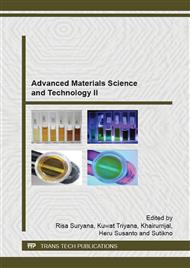[1]
P. Marwoto, Sulhadi, Sugianto, D. Aryanto, E. Wibowo, K. Wahyuningsih, Room-temperature deposition of zno thin films by using dc magnetron sputtering, Advanced Materials Research 896 (2014) 237-240.
DOI: 10.4028/www.scientific.net/amr.896.237
Google Scholar
[2]
P. Marwoto, Sugianto, E. Wibowo, Growth of europium-doped gallium oxide (Ga2O3: Eu) thin films deposited by homemade DC magnetron sputtering, Journal of Theoretical and Applied Physics 6 (2012) 17.
DOI: 10.1186/2251-7235-6-17
Google Scholar
[3]
T. Tynell, R. Okazaki, I. Terasaki, H. Yamaechi, M. Karppinen, Electron doping of ALD-grown ZnO thin films through Al and P substitutions, Journal of Materials Science 48 (2013) 2806-2811.
DOI: 10.1007/s10853-012-6942-9
Google Scholar
[4]
R.S. Ajimsha, A.K. Das, B.N. Singh, P. Misra, L.M. Kukreja, Structural, electrical and optical properties of dy doped ZnO thin films grown by buffer assisted pulsed laser deposition, Physica E 4 (2010) 1838-18432.
DOI: 10.1016/j.physe.2010.02.005
Google Scholar
[5]
K. U. Sim, S. W. Shin, A.V. Moholkar, J. H. Yun, J. H. Moon, J. H. Kim, Effects of dopant (Al, Ga, and In) on the characteristics of ZnO thin films prepared by RF magnetron sputtering system, Current Applied Physics 10 (2010) 463-467.
DOI: 10.1016/j.cap.2010.02.028
Google Scholar
[6]
G.G. Valle, P. Hammer, S.H. Pulcinelli, C.V. Santilli, Transparent and conductive ZnO: Al thin films prepared by sol-gel dip-coating, Journal of the European Ceramic Society 24 (2004) 1009-1013.
DOI: 10.1016/s0955-2219(03)00597-1
Google Scholar
[7]
H. M. Zhou, , D.Q. Yi, Z. M. Yu, L. R. Xiao, J. Li, Preparation of aluminum doped zinc oxide films and the study of their microstructure, electrical and optical properties, Thin Solid Films 515 (2007) 6909-6914.
DOI: 10.1016/j.tsf.2007.01.041
Google Scholar
[8]
W. Yang, Z. Liu, D. L. Peng, F. Zhang, H. Huang, Y. Xie, Z. Wu, Room-temperature deposition of transparent conducting by RF magnetron sputtering method, Applied Surface Science 255 (2009) 5669-5673.
DOI: 10.1016/j.apsusc.2008.12.021
Google Scholar
[9]
S. Y. Kuo, W. C. Chen, F. I. Lai, C. P. Cheng, H. C. Kuo, S. C. Wang, W. F. Hsieh, Effects of Doping Concentration and Annealing Temperature on Properties of Highly-Oriented Al-Doped ZnO Films, Journal of Crystal Growth 287 (2006) 78–84.
DOI: 10.1016/j.jcrysgro.2005.10.047
Google Scholar
[10]
K. Yim, H. Kim, C. Lee, Effects of the O2/Ar gas flow ratio on the electrical and transmittance properties of Zno: Al films deposited by RF magnetron sputtering, Journal of Electroceramics 17 (2006) 875-877.
DOI: 10.1007/s10832-006-7036-3
Google Scholar
[11]
Chaabouni, F. M. Abaab, B. Rezig, Effect of the substrate temperature on the Properties of ZnO films grown by RF magnetron sputtering, Materials Science and Engineering B 109 (2004) 236–240.
DOI: 10.1016/j.mseb.2003.10.105
Google Scholar


